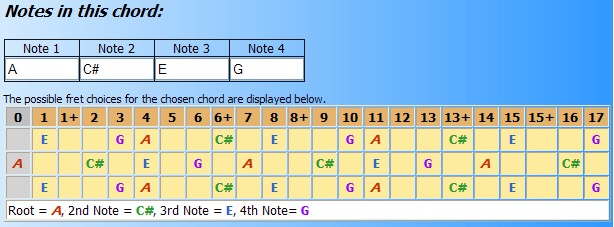Chord Wizard Tutorial
Use of the Chord Wizard is two-fold:
1) Finding all the possible fingerings for a given chord.
2) Finding all the possible chords given one or more notes in a chord.
Tuning
Note Naming Convention.
The chord wizard is designed around a dulcimer fret board with
1+, 6+, 8+ and 13+ frets. By default the tuning is DAd. This can
be changed. The first section of the chord wizard permits each
string to be tuned. The convention used here is that lower-case
c is middle C on the piano keyboard. Notes
immediately below middle C are capital letters, e.g. B, A,
G, F, E, D, C. Notes above and including middle C are
c, d, e, f, g, a, b. The next octave above middle C
would be indicated by a prime designation and lower case
letters. That is, c', d', e', f', etc. Notes an
octave below middle C would be capital letters with prime
designation. That is, B', A', G', F', E', D', C'.
Of course, sharps and flats would be included in this
convention. In summary, DAd would be D
below middle C for the bass string, A below middle
C for the middle string and d above middle C for
the melody string(s).
Fingering a Chord
Let's say that you want to play a chord designated in a score of music.

The music above is an excerpt from Silent Night. Note the chords above measures 1, 3 and 4. The chord above measure 3 is A7. The notes in this chord are A, C#, E and G. With only three strings we can only play three notes of the A7 chord but those notes are ours to choose. But which ones and what fingering? Tip: Playing A, C#, and E would be an A chord. However, by dropping the C# or E and playing the G, you can add suspense to the tune then resolve that suspense by finishing with the D chord. Try all combinations and let your ears decide which is best.
Just below Fret Choice there is a box including Root Note,
Major Chords, Extended Chords and Obscure Chords. For
the A7, or A dominant 7th to be precise, the root note is
A. The chord type is a dominant 7th or 7. With your
mouse, select the root note, A. Next move the
mouse to the major chords and select 7. The
other boxes, Extended Chords and Obscure Chords
should indicate ---. More on this later. Finally,
click on Fret Choice.
After clicking on Fret Choice, the dulcimer fret board
below this section will display

The top table will show the notes in the chord, A, C#, E and G. Below this table is the dulcimer fret board in the tuning that you have chosen. If we want to play the root note A on the melody or predominant string, we can finger fret 4 or fret 11. In order to distinguish between an A chord and and A7 chord we should choose the 7th or G. We can get this on the middle string at fret 6 or 13. On the bass string we can get the G at frets 3, 10 or 17. We then need to choose a C# or E note. Good choices are 3, 2, 4 (bass to melody) or 3,4,4. The actual choice depends on the sound that you like and the previous fingering for the previous chord or note and, also, where you are going from here. I often select one fingering only to change this because of playability or sound. Since Missy and I play together, my selection also depends on what Missy is doing.
You do not have to play all notes in a chord. For the A7 chord, you could finger 4,0,4. That would be all A notes and not too pleasing but it would work. Why would we do this? Let's say that you are playing backup for a song in B-flat (that's A#). Colors are used for your convenience. If you want a full chord (and it's possible), select one of each color. Again, for chords requiring four notes, this is not possible.

If you have a 1+ fret, you can only get two of the notes, F and D. There is no A# without retuning. Without the 1+ fret you can only get the D by playing 0,3,0 or 7,3,7 if capo'd on 3. You won't be taking lead here but you can at least play part of a B-flat chord.
The chord wizard separates all the chords into three groups, major, extended and obscure. You should take some time and explore the possibilities. There are nearly 150 choices that I have tried to simplify. If you want an obscure chord like a 7th add 9, make sure that the other two chord-type boxes show ---.